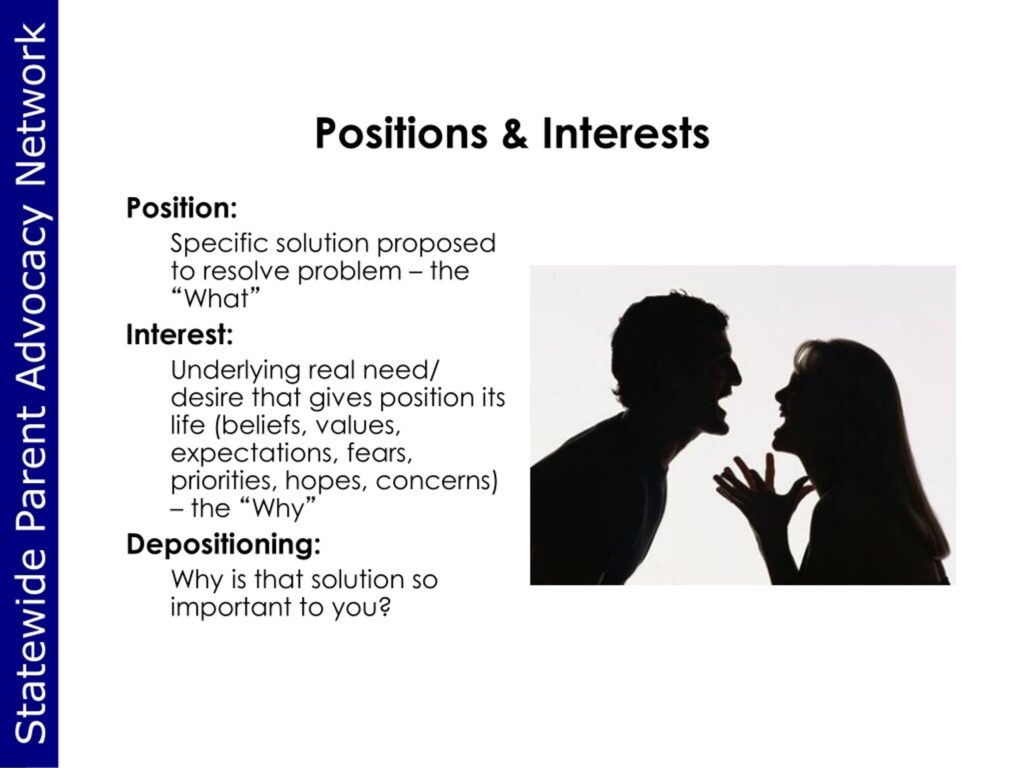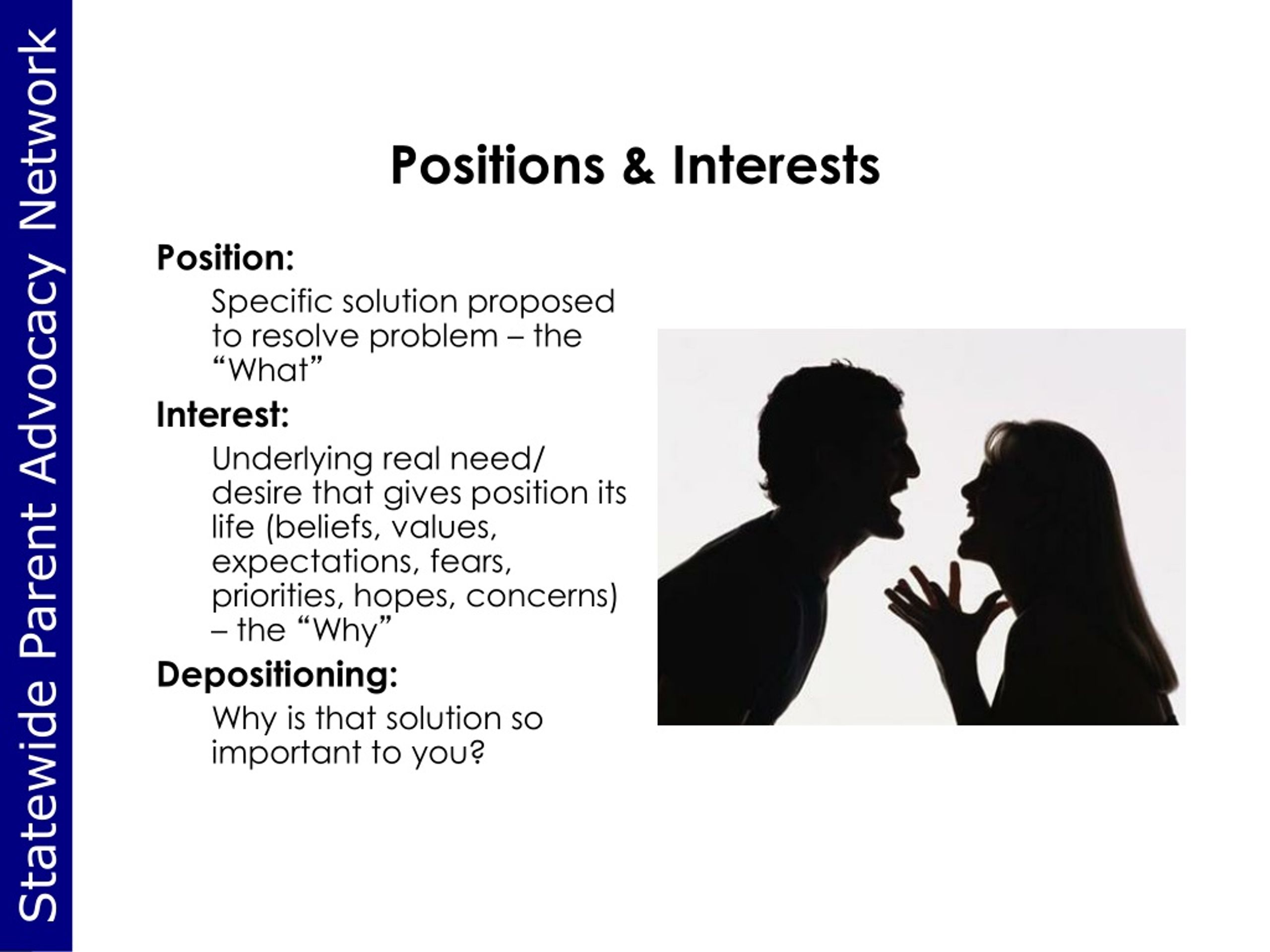
Interests vs. Positions: Understanding the Core of Effective Negotiation
In the realm of negotiation, whether it’s a high-stakes business deal, a delicate diplomatic discussion, or a simple disagreement at home, understanding the difference between interests vs. positions is paramount. Many negotiations falter because participants get stuck defending their positions without ever exploring the underlying interests that drive them. This article delves into the critical distinction between these two concepts, providing insights and practical strategies for navigating negotiations more effectively.
Simply put, a position is what someone wants, while an interest is why they want it. Confusing these two can lead to impasse, frustration, and ultimately, failed negotiations. The key to successful negotiation lies in uncovering the hidden interests that motivate each party, allowing for creative solutions that satisfy everyone’s needs. Understanding the nuances of interests vs. positions is a vital skill for anyone seeking to resolve conflict and achieve mutually beneficial outcomes.
Defining Positions and Interests
To truly grasp the difference between interests vs. positions, let’s examine each concept more closely:
Positions: The Stated Demands
A position is a specific stance or demand that a party takes in a negotiation. It’s often presented as a non-negotiable requirement or a concrete solution. Think of it as the ‘what’ in the negotiation. Examples of positions include:
- “I want a 10% raise.”
- “We need a 5-year contract.”
- “I demand full ownership of the intellectual property.”
Positions are often rigid and can limit the scope of potential solutions. When parties focus solely on their positions, they may miss opportunities for creative problem-solving that could better address their underlying needs. Focusing only on the interests vs. positions can lead to a deadlock.
Interests: The Underlying Needs and Desires
An interest, on the other hand, is the underlying need, desire, fear, or motivation that drives a party to take a particular position. It’s the ‘why’ behind the ‘what.’ Interests are often less tangible than positions and may be unspoken or even unconscious. Uncovering the interests vs. positions is crucial for successful negotiations. Examples of interests include:
- Security: The need for stability, protection, or predictability.
- Recognition: The desire for appreciation, respect, or validation.
- Control: The need to influence decisions or outcomes.
- Economic well-being: The desire for financial security or profit.
- Relationship: The need to maintain positive relationships with others.
By identifying the interests behind each party’s positions, negotiators can explore a wider range of options that satisfy those underlying needs, even if the original positions are incompatible. Considering the interests vs. positions creates room for innovative solutions.
Why Focusing on Interests is Crucial
Shifting the focus from positions to interests vs. positions offers several significant advantages in negotiation:
- Increased Flexibility: When you understand the underlying interests, you can explore multiple ways to satisfy them, rather than being locked into a single, rigid position.
- Improved Communication: Focusing on interests encourages open dialogue and active listening, fostering a more collaborative and understanding environment.
- Creative Solutions: By identifying the shared and compatible interests, you can develop solutions that address the needs of all parties involved, leading to mutually beneficial outcomes.
- Stronger Relationships: Addressing underlying interests demonstrates empathy and a willingness to understand the other party’s perspective, strengthening the relationship and building trust.
- Reduced Conflict: Understanding the ‘why’ behind a position can help to de-escalate conflict and find common ground, even when positions seem diametrically opposed.
Therefore, understanding the difference between interests vs. positions is not just a theoretical exercise, but a practical tool for achieving more successful and satisfying negotiation outcomes. Ignoring the interests vs. positions can lead to failed negotiations.
Identifying Interests: Techniques and Strategies
Uncovering the underlying interests in a negotiation requires careful observation, active listening, and strategic questioning. Here are some techniques to help you identify interests:
Ask Open-Ended Questions
Instead of asking questions that can be answered with a simple ‘yes’ or ‘no,’ use open-ended questions that encourage the other party to elaborate on their motivations and concerns. For example:
- “What are your priorities in this situation?”
- “What are you hoping to achieve?”
- “What are your concerns about this proposal?”
- “Why is this important to you?”
Listen Actively and Empathetically
Pay close attention to both the verbal and nonverbal cues of the other party. Try to understand their perspective and acknowledge their feelings. Show genuine interest in their concerns and avoid interrupting or judging. Active listening is key to understanding the interests vs. positions.
Put Yourself in Their Shoes
Try to imagine the situation from the other party’s point of view. What are their needs, fears, and aspirations? What are the pressures they are facing? By understanding their perspective, you can better anticipate their interests and develop solutions that address their concerns. Understanding the interests vs. positions requires empathy.
Identify Shared Interests
Look for areas where your interests align with the other party’s. Shared interests can serve as a foundation for building trust and finding common ground. Highlighting these shared interests can help to create a more collaborative and cooperative atmosphere. Focusing on shared interests vs. positions is a great strategy.
Don’t Assume
Avoid making assumptions about the other party’s interests. Always verify your understanding by asking clarifying questions and actively listening to their responses. Assumptions can lead to misunderstandings and missed opportunities. Understanding the interests vs. positions requires careful analysis, not assumptions.
Look Beyond the Obvious
Sometimes, the most important interests are not immediately apparent. Dig deeper by asking follow-up questions and exploring the underlying motivations behind the stated positions. The real interests vs. positions may be hidden beneath the surface.
Case Studies: Interests vs. Positions in Action
To illustrate the importance of understanding interests vs. positions, let’s consider a few examples:
Case Study 1: The Salary Negotiation
Position: An employee demands a $10,000 raise.
Interest: The employee feels undervalued and seeks recognition for their contributions. They also have increased financial responsibilities due to a growing family. Another interest vs. positions example to consider.
Instead of simply rejecting the raise, the employer could explore alternative ways to address the employee’s interests. This might include offering a promotion, providing additional training opportunities, or offering flexible work arrangements to help with childcare costs. By focusing on the underlying interests, the employer can find a solution that satisfies the employee’s needs without necessarily granting the full salary increase.
Case Study 2: The Contract Dispute
Position: A vendor demands full payment for services rendered, even though the client is dissatisfied with the quality of the work.
Interest: The vendor needs the money to cover their operating expenses and maintain their reputation. The client wants to receive the promised level of service and avoid paying for substandard work. Another interest vs. positions example to consider.
Instead of engaging in a protracted legal battle, the parties could explore options such as renegotiating the contract, offering a partial refund, or providing additional services to rectify the deficiencies. By focusing on the underlying interests, they can find a solution that protects both the vendor’s financial stability and the client’s satisfaction.
Case Study 3: The International Treaty Negotiation
Position: One country demands that another country reduce its carbon emissions by 50%.
Interest: The first country is concerned about the impacts of climate change and wants to protect its environment. The second country is concerned about the economic impact of reducing emissions and wants to maintain its industrial competitiveness. Another interest vs. positions example to consider.
Instead of focusing solely on the emission reduction target, the countries could explore alternative solutions such as investing in renewable energy technologies, providing financial assistance to help the second country transition to a low-carbon economy, or collaborating on research and development initiatives. By addressing the underlying interests, they can find a solution that protects the environment while also supporting economic development.
Practical Tips for Negotiating with Interests in Mind
Here are some practical tips for incorporating the interests vs. positions framework into your negotiation strategy:
- Prepare Thoroughly: Before entering a negotiation, take the time to research the other party’s background, motivations, and potential interests.
- Build Rapport: Establish a positive relationship with the other party by finding common ground and demonstrating genuine interest in their perspective.
- Ask Questions: Use open-ended questions to uncover the underlying interests driving their positions.
- Listen Actively: Pay close attention to their responses and try to understand their point of view.
- Brainstorm Solutions: Generate a wide range of potential solutions that address the interests of all parties involved.
- Evaluate Options: Carefully evaluate each option based on its ability to satisfy the underlying interests and achieve mutually beneficial outcomes.
- Be Creative: Don’t be afraid to think outside the box and explore unconventional solutions.
- Be Flexible: Be willing to adjust your own positions and priorities as you learn more about the other party’s interests.
- Document Agreements: Clearly document all agreements in writing to avoid misunderstandings and ensure accountability.
By consistently applying these principles, you can significantly improve your negotiation skills and achieve more successful and satisfying outcomes. Remember, the key to effective negotiation lies in understanding the difference between interests vs. positions and focusing on the underlying needs and desires of all parties involved.
Conclusion: Mastering the Art of Interest-Based Negotiation
In conclusion, mastering the art of negotiation requires a deep understanding of the distinction between interests vs. positions. By shifting the focus from rigid demands to the underlying needs and motivations, negotiators can unlock a world of possibilities and achieve mutually beneficial outcomes. This approach fosters collaboration, strengthens relationships, and ultimately leads to more sustainable and satisfying agreements. So, the next time you find yourself in a negotiation, remember to look beyond the surface and explore the underlying interests – you’ll be surprised at what you discover. Understanding the interests vs. positions is a cornerstone of effective negotiation. [See also: Negotiation Strategies for Success]

